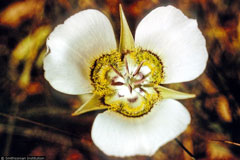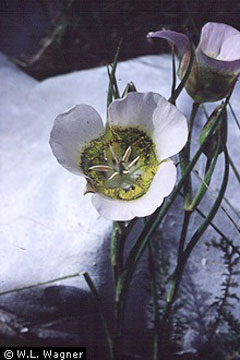 |
|
R.A. Howard @ USDA-NRCS PLANTS Database |
 |
| W.L. Wagner @ USDA-NRCS PLANTS Database |
Translate this page:
Summary
Gunnison’s Mariposa Lily is a high-elevation counterpart to the more desert-adapted Calochortus species. Found across the Rocky Mountains and Intermountain West, it adorns mountain meadows and sagebrush foothills with its iconic tulip-like blooms—white to lilac with purple or green markings and a dense patch of hairs near the petal base. This species is both beautiful and practical, producing a starchy, edible bulb long valued by Indigenous peoples. It is well adapted to cold winters, moist springs, and dry summers, representing one of the most northerly and frost-hardy Calochortus species.
Physical Characteristics

 Calochortus gunnisonii is a BULB growing to 0.3 m (1ft).
Calochortus gunnisonii is a BULB growing to 0.3 m (1ft).
See above for USDA hardiness. It is hardy to UK zone 4. It is in flower from June to July. The species is hermaphrodite (has both male and female organs) and is pollinated by Insects.
Suitable for: light (sandy) and medium (loamy) soils and prefers well-drained soil. Suitable pH: mildly acid, neutral and basic (mildly alkaline) soils. It cannot grow in the shade. It prefers dry or moist soil.
UK Hardiness Map
US Hardiness Map
Synonyms
C. gunnisonii var. gunnisonii
Plant Habitats
East Wall. By. South Wall. By.
Edible Uses
Edible Parts: Flowers Leaves Root Seed
Edible Uses:
Bulb - raw or cooked[46, 105, 161]. One report says that the raw bulb tastes like a raw new potato[183]. It has a crisp nut-like texture and a pleasant flavour when cooked[85, 183]. The bulb can be dried and ground into a powder for making a sweet porridge, mush etc[85, 183, 257]. Leaves - cooked. It is hard to obtain a sufficient quantity[85] and use of the leaves will weaken the bulbs. Seed - ground into a powder[85, 183]. Flower buds - raw. Added to salads[85, 183]. The bulbs are edible and highly regarded for their flavor, while the leaves and seeds have limited nutritional value. The bulbs were eaten by several Native American groups, including the Ute and Shoshone, who roasted or boiled them as a sweet, starchy vegetable. The flavor is mild, without bitterness or mucilage [2-3]. Edibility rating: 4.5/5 for bulbs; 1/5 for leaves and seeds. Taste, Processing & Kitchen Notes: When roasted, the bulbs become soft and sweet, similar in flavor to roasted chestnuts or parsnips. Boiling produces a milder, potato-like taste. Fresh bulbs are crisp and faintly nutty when raw but are best consumed cooked, as this enhances digestibility and sweetness. Indigenous peoples often roasted them in earth pits or boiled them in baskets with hot stones. Dried bulbs can be stored and later reconstituted in stews or soups [2-3]. Seasonality (Phenology): Flowering: June–August, depending on altitude. Fruiting: Late July–September. Dormancy: By late summer, the plant’s aerial parts wither completely. Harvest: Bulbs can be collected from late spring through early autumn, ideally after seed set, when energy reserves are at their peak. Safety & Cautions (Food Use): Bulbs are edible only when thoroughly cooked. Raw bulbs can cause mild gastrointestinal upset. As with all Calochortus species, collection from protected areas should be avoided to preserve wild populations. Harvest & Processing Workflow: Locate mature flowering plants in early summer, then mark sites for later harvest once seed capsules dry. Carefully dig bulbs using a narrow trowel or stick. Wash, peel, and cook by roasting or boiling 15–20 minutes. Bulbs can be sun-dried for storage or roasted immediately. Traditional / Indigenous Use Summary: The Ute, Shoshone, and Paiute peoples valued C. gunnisonii bulbs as a nutritious, starchy food. They roasted them whole in ashes or boiled them with meat. In some traditions, the plant also held symbolic meaning associated with survival, renewal, and gratitude for seasonal abundance.
References More on Edible Uses
Medicinal Uses
Plants For A Future can not take any responsibility for any adverse effects from the use of plants. Always seek advice from a professional before using a plant medicinally.
Antirheumatic Miscellany
An infusion of the plant has been taken internally to treat rheumatic swellings and to ease the delivery of the placenta[257].
References More on Medicinal Uses
The Bookshop: Edible Plant Books
Our Latest books on Perennial Plants For Food Forests and Permaculture Gardens in paperback or digital formats.

Edible Tropical Plants
Food Forest Plants for Hotter Conditions: 250+ Plants For Tropical Food Forests & Permaculture Gardens.
More

Edible Temperate Plants
Plants for Your Food Forest: 500 Plants for Temperate Food Forests & Permaculture Gardens.
More

More Books
PFAF have eight books available in paperback and digital formats. Browse the shop for more information.
Shop Now
Other Uses
Miscellany
In some traditions, the plant also held symbolic meaning associated with survival, renewal, and gratitude for seasonal abundance. Ecology & Wildlife: The flowers attract native bees and hoverflies, which pollinate while collecting nectar and pollen. Rodents and voles sometimes eat the bulbs, and deer occasionally browse foliage. The species contributes to the biodiversity of montane pollinator networks and helps stabilize fragile soils through its bulbous root system. Performs well in rock gardens, native meadow restorations, and high-altitude xeriscapes. Ethereal flowers continue to inspire naturalists and gardeners alike.
Special Uses
References More on Other Uses
Cultivation details
Gunnison’s Mariposa Lily prefers well-drained, sandy or loamy soils in open meadows, sagebrush flats, and mountain foothills. It thrives in full sun with cool, moist springs and dry summers. Tolerant of frost and snow cover, it is well suited to USDA Hardiness Zones 4–8. Overwatering or heavy clay soils lead to bulb rot. Requires a deep very well-drained fertile sandy soil in a sunny position and must be kept dry from mid summer to late autumn[1, 60, 200]. This is a rather difficult plant to cultivate in Britain, it is very cold hardy but is intolerant of wetness especially in the winter[1, 42]. It is easiest to grow in a bulb frame but is worth trying outdoors at the base of a south-facing wall, especially with shrubs that like these conditions[120]. Bulbs can be lifted as soon as the foliage dies down in the summer and stored overwinter in a cool dry place, replanting in the spring[138]. The bulbs must be replanted immediately according to another report[1]. Bulbs frequently divide after flowering, the bulblets taking 2 years to reach flowering size[200]. This species is closely related to C. ambiguus[214]. Hand pollination is necessary if seed is required[1]. Habitat & Range: Native to Colorado, Utah, Wyoming, New Mexico, and northern Arizona, this species occurs primarily between 1,500 and 3,000 meters elevation. It favors montane grasslands, aspen openings, and sagebrush steppe—often flowering abundantly after wet springs. It is especially common in the Gunnison Basin of Colorado, from which its name derives. Size & Landscape Performance: Typically 15–45 cm tall and 10–25 cm wide, Gunnison’s Mariposa Lily produces spectacular displays in spring and early summer. In cultivation, it is hardy and resilient, performing well in rock gardens, native meadow restorations, and high-altitude xeriscapes. Pests & Problems: Few natural pests exist, though bulb rot can occur under prolonged soil moisture. Gophers or voles may dig bulbs in winter. In cultivation, fungal disease may arise in overly shaded or compacted sites.
References Carbon Farming Information and Carbon Sequestration Information
Temperature Converter
Type a value in the Celsius field to convert the value to Fahrenheit:
Fahrenheit:
The PFAF Bookshop
Plants For A Future have a number of books available in paperback and digital form. Book titles include Edible Plants, Edible Perennials, Edible Trees,Edible Shrubs, Woodland Gardening, and Temperate Food Forest Plants. Our new book is Food Forest Plants For Hotter Conditions (Tropical and Sub-Tropical).
Shop Now
Plant Propagation
Seed - sow as soon as ripe or early spring in a cold frame in a very sharply draining medium. Stratification may be helpful. Germination usually takes place within 1 - 6 months at 15°c[138]. Leave the seedlings undisturbed for their first two years growth[138], but give them an occasional liquid feed to ensure they do not become nutrient deficient. It is quite difficult to get the seedlings through their first period of dormancy since it is all too easy either to dry them out completely or keep them too moist when they will rot[214]. After their second year of growth, pot up the dormant bulbs in late summer and grow them on for at least another 2 years in the greenhouse before trying them outside. Seedlings take about 5 - 7 years to come into flower[214]. Division of the bulbs as soon as the foliage dies down. The bulbs can be planted straight out into their permanent positions but in areas with wet winters it might be best to store them overwinter and replant them in the spring. Stem bulbils, harvested from the stems after flowering. They can be stored cool and dry then planted in pots in the cold frame in the spring.
Other Names
If available other names are mentioned here
Gunnison’s Mariposa Lily (Calochortus gunnisonii S. Watson)
Native Range
NORTHERN AMERICA: United States (Nebraska, South Dakota, Colorado, Montana, Wyoming, New Mexico, Arizona, Utah)
Weed Potential
Right plant wrong place. We are currently updating this section.
Please note that a plant may be invasive in one area but may not in your area so it's worth checking.
None. The plant is not aggressive and reproduces slowly from seed and bulb division. It is sensitive to habitat disturbance and over-collection.
Conservation Status
IUCN Red List of Threatened Plants Status :

Growth: S = slow M = medium F = fast. Soil: L = light (sandy) M = medium H = heavy (clay). pH: A = acid N = neutral B = basic (alkaline). Shade: F = full shade S = semi-shade N = no shade. Moisture: D = dry M = Moist We = wet Wa = water.
Now available:
Food Forest Plants for Mediterranean Conditions
350+ Perennial Plants For Mediterranean and Drier Food Forests and Permaculture Gardens.
[Paperback and eBook]
This is the third in Plants For A Future's series of plant guides for food forests tailored to
specific climate zones. Following volumes on temperate and tropical ecosystems, this book focuses
on species suited to Mediterranean conditions—regions with hot, dry summers and cool, wet winters,
often facing the added challenge of climate change.
Read More
Expert comment
Author
S.Watson.
Botanical References
60200
Links / References
For a list of references used on this page please go here
Readers comment